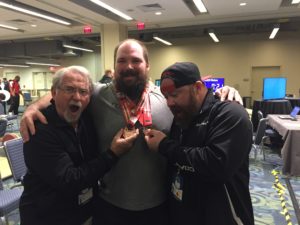Remember we will be in San Antonio, TX April 11-12 at Mission CrossFit, and then April 18-19 I am in Whitby, Ontario at CrossFit Whitby! Check out all of the Learn 2 Lift Certs. below:
Join one of our Online Teams:
Mash Mafia Online Weightlifting Team
Checklist When Developing a Program
Today I was on a phone call with Michael Coopman. Michael had purchased a consultation with me to discuss programming for his own athletes. First I want to say that he was pretty much on point, but I was able to give him some solid insight on the things to consider. The talk actually got me thinking about all the things that go into a program.
I have been writing programs for over 25 years. Now I go into autopilot, but there are some important things to consider. A lot of you are already good at writing programs, but hopefully some of these points will make you even better. I model my business after EliteFTS, and the great Dave Tate. My goal is to educate all of you. I always want about 70% of my information to be free. I want to know at the end of my life that I have helped as many people as possible while on this earth.
I have had so many influences in my life that have led to the way that I program some of the major influences include: Louie Simmons, Ed Coan, Jim Wendler, Paul Childress, Chad Wesley Smith, Don McCauley, Glenn Pendlay, Zygmunt Smalcerz, Greg Everett, Travis Cooper, Greg Nuckols, and anything that I can get my hands on about the Chinese Program. I want you all to notice the range. You probably expected Don McCauley, Louie, and Glenn Pendlay, but there were a few names that you probably weren’t expecting. Travis Cooper is one of my own athletes, and Greg Nuckols used to be. Both of them are super young, but heck I will learn from anyone that has good ideas. I refuse to let my pride get in the way of being the best coach in America.
Here are the points that I consider when writing a plan:
1. Age of the athlete- until about age 18, I am going to focus on general physical preparedness and technique. We are going to crush the squats, presses, rows, and pulls, and we are going to drill snatch and clean & jerk until form is perfect. From 18 years old and on, the workout becomes more specific to snatch and clean & jerk. You will still get them strong, but the focus will shift.
2. Training Age- The first two to three years of training is almost the same as training youth. There is a focus on technique and general strength. When the athlete has around 5 years into the sport, the athlete should focus on snatch and clean & jerk, and targeting any weakness that a coach might identify. Having a solid muscular balance testing protocol can be very helpful, and it can help quantify progress. Remember the athlete hasn’t mastered the sport until around 10 years of training. That means there is plenty of time to greatly affect the career of your athlete.
3. How far out from a major competition? Once an athlete is 6 weeks out from a major competition, it is time to focus on the minimums and maximums of snatch and clean & jerk. The volume of squats, pulls, and other strength work will decrease. I suggest keeping the intensity high to keep the legs strong, but overall volume low. If you have 12-15 weeks to prepare, I suggest focusing on targeting all weaknesses. For example, if overhead stability is the issue, focus on carries and presses. If someone has a lagging jerk, use a good bit of your volume to target the jerk. You don’t have to squat three times per week. You don’t have to Snatch and Clean & Jerk three times per week each. If you have a massive squat, good snatch, good clean, and your jerk is terrible, focus on that jerk. Jerk technique, push press, and other exercises to improve the jerk should be applied to help the athlete improve.
4. What’s the target competition for the year? For some it’s the Nationals. For others, it’s the World Championships. Obviously one wants to taper the most for the competition that is the most important. Until that time, the athlete should continue targeting those weaknesses and increasing their work capacity.
5. Specific athlete needs for mobility, stability, and recovery! This is one area that most coaches skip, and that is the coach having a shortsighted view of training. The athletes that I coach are some of the best in the business, and I believe in each and every one of them. I am thinking long term for each of them, so I want to target any deficiencies. If something needs stabilizing, then I will prescribe the necessary exercises. If mobility is the issue, I have a long list of exercises to target the problem areas. If my athletes aren’t recovering, then nothing will help them improve. A great coach takes a holistic approach to programming.
I hope that these points help you guys to develop solid plans for your athletes. If you have specific questions, you might want to look into purchasing a Consultation with me. Click on the link below to find out more:
When it comes to programming, growing your melting pot is key. Learn from as many credible sources as possible, and then take what works and leave what doesn’t. Programming should be the Strength & Conditioning/Weightlifting/Powerlifting Coach’s artwork. This is where we show our creativity, experience, and knowledge. I suggest taking this aspect very seriously.
For one on one Online Coaching with Coach Mash, click on the link below:
